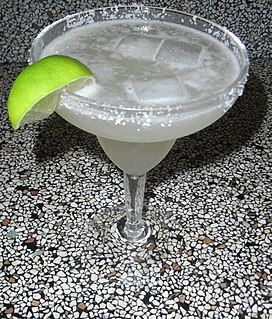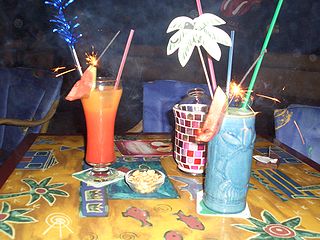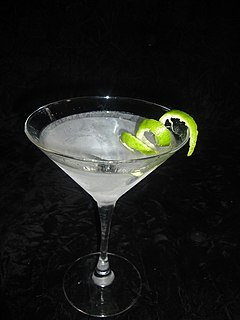A citrus cocktail or citrus-forward cocktail is a cocktail whose dominant taste is that of a citrus fruit. Examples include the Bee's Knees, margarita, caipirinha, or Spanish-style gin and tonic. Citrus tonics are often gin-based because of the citrus and other floral elements used in the distillation process. Limoncello is also sometimes used. [1] Mint is sometimes used as a cooling element to citrus-forward cocktails. [2] Spicy vodkas, such as a green chile vodka with lime and cilantro, can also be used. [3]

A Bees Knees is a Prohibition Era cocktail made with Gin, fresh lemon juice, and honey. It is served shaken and chilled, often with a lemon twist.

A margarita is a cocktail consisting of tequila, orange liqueur, and lime juice often served with salt on the rim of the glass. The drink is served shaken with ice, blended with ice, or without ice. Although it has become acceptable to serve a margarita in a wide variety of glass types, ranging from cocktail and wine glasses to pint glasses and even large schooners, the drink is traditionally served in the eponymous margarita glass, a stepped-diameter variant of a cocktail glass or champagne coupe.

Caipirinha is Brazil's national cocktail, made with cachaça, sugar, and lime. Cachaça, also known as caninha, or any one of a multitude of traditional names, is Brazil's most common distilled alcoholic beverage. Although both rum and cachaça are made from sugarcane-derived products, in cachaça the alcohol results from the fermentation of fresh sugarcane juice that is then distilled, while rum is usually made from refinery by-products such as molasses.
Citrus cocktails are often paired with piquant Mexican and Asian foods so that the tartness will serve as a foil for the spices. [4] Citrus-forward cocktails are also sometimes paired with seafood. [5]

Mexican cuisine began about 9000 years ago, when agricultural communities such as the Maya formed, domesticating maize, creating the standard process of corn nixtamalization, and establishing their foodways. Successive waves of other Mesoamerican groups brought with them their own cooking methods. These included the Olmec, Teotihuacanos, Toltec, Huastec, Zapotec, Mixtec, Otomi, Purépecha, Totonac, Mazatec, and Mazahua.

Asian cuisine includes several major regional cuisines: Central Asian, East Asian, North Asian, South Asian, Southeast Asian, and West Asian. A cuisine is a characteristic style of cooking practices and traditions, usually associated with a specific culture. Asia, being the largest and most populous continent, is home to many cultures, many of which have their own characteristic cuisine.

Seafood is any form of sea life regarded as food by humans, prominently including fish and shellfish. Shellfish include various species of molluscs, crustaceans, and echinoderms. Historically, marine mammals such as cetaceans as well as seals have been eaten as food, though that happens to a lesser extent in modern times. Edible sea plants such as some seaweeds and microalgae are widely eaten as sea vegetables around the world, especially in Asia. In North America, although not generally in the United Kingdom, the term "seafood" is extended to fresh water organisms eaten by humans, so all edible aquatic life may be referred to as "seafood". For the sake of completeness, this article is inclusive of all edible aquatic life.
The opposite of a citrus cocktail would be a spirit-forward cocktail, in which the spirit is the core flavor, and other ingredients such as bitters and shrubs are used to highlight the base spirit. [6]
A spirit-forward cocktail is a class of strong cocktails. Spirit-forward cocktails, other than the ancestral cocktails, typically use fortified wine such as vermouth, sherry, quinquina, or port to blunt the taste of the alcohol in the base spirit and add complexity of flavor. In a spirit-forward cocktail, it is still possible to taste the base spirits because they have not been completely masked by sugars and fruit juices. The opposite of a spirit-forward cocktail is a citrus cocktail.

A bitters is traditionally an alcoholic preparation flavored with botanical matter so that the end result is characterized by a bitter, sour, or bittersweet flavor. Numerous longstanding brands of bitters were originally developed as patent medicines, but now are sold as digestifs, sometimes with herbal properties, and cocktail flavorings. Since cocktails mainly contain sour and sweet flavors, bitters are used to engage another primary taste and thereby balance out the drink and make it more complex, giving it a more complete flavor profile.

In terms of mixed drinks, shrub is the name of two different, but related, acidulated beverages. One type of shrub is a fruit liqueur that was popular in 17th and 18th century England, typically made with rum or brandy, and mixed with sugar and the juice or rinds of citrus fruit.











